Siyuan Wang
Fudan University
HardcoreLogic: Challenging Large Reasoning Models with Long-tail Logic Puzzle Games
Oct 14, 2025Abstract:Large Reasoning Models (LRMs) have demonstrated impressive performance on complex tasks, including logical puzzle games that require deriving solutions satisfying all constraints. However, whether they can flexibly apply appropriate rules to varying conditions, particularly when faced with non-canonical game variants, remains an open question. Existing corpora focus on popular puzzles like 9x9 Sudoku, risking overfitting to canonical formats and memorization of solution patterns, which can mask deficiencies in understanding novel rules or adapting strategies to new variants. To address this, we introduce HardcoreLogic, a challenging benchmark of over 5,000 puzzles across 10 games, designed to test the robustness of LRMs on the "long-tail" of logical games. HardcoreLogic systematically transforms canonical puzzles through three dimensions: Increased Complexity (IC), Uncommon Elements (UE), and Unsolvable Puzzles (UP), reducing reliance on shortcut memorization. Evaluations on a diverse set of LRMs reveal significant performance drops, even for models achieving top scores on existing benchmarks, indicating heavy reliance on memorized stereotypes. While increased complexity is the dominant source of difficulty, models also struggle with subtle rule variations that do not necessarily increase puzzle difficulty. Our systematic error analysis on solvable and unsolvable puzzles further highlights gaps in genuine reasoning. Overall, HardcoreLogic exposes the limitations of current LRMs and establishes a benchmark for advancing high-level logical reasoning.
SMILE: SeMantic Ids Enhanced CoLd Item Representation for Click-through Rate Prediction in E-commerce SEarch
Oct 14, 2025Abstract:With the rise of modern search and recommendation platforms, insufficient collaborative information of cold-start items exacerbates the Matthew effect of existing platform items, challenging platform diversity and becoming a longstanding issue. Existing methods align items' side content with collaborative information to transfer collaborative signals from high-popularity items to cold-start items. However, these methods fail to account for the asymmetry between collaboration and content, nor the fine-grained differences among items. To address these issues, we propose SMILE, an item representation enhancement approach based on fused alignment of semantic IDs. Specifically, we use RQ-OPQ encoding to quantize item content and collaborative information, followed by a two-step alignment: RQ encoding transfers shared collaborative signals across items, while OPQ encoding learns differentiated information of items. Comprehensive offline experiments on large-scale industrial datasets demonstrate superiority of SMILE, and rigorous online A/B tests confirm statistically significant improvements: item CTR +1.66%, buyers +1.57%, and order volume +2.17%.
Marine Chlorophyll Prediction and Driver Analysis based on LSTM-RF Hybrid Models
Aug 07, 2025Abstract:Marine chlorophyll concentration is an important indicator of ecosystem health and carbon cycle strength, and its accurate prediction is crucial for red tide warning and ecological response. In this paper, we propose a LSTM-RF hybrid model that combines the advantages of LSTM and RF, which solves the deficiencies of a single model in time-series modelling and nonlinear feature portrayal. Trained with multi-source ocean data(temperature, salinity, dissolved oxygen, etc.), the experimental results show that the LSTM-RF model has an R^2 of 0.5386, an MSE of 0.005806, and an MAE of 0.057147 on the test set, which is significantly better than using LSTM (R^2 = 0.0208) and RF (R^2 =0.4934) alone , respectively. The standardised treatment and sliding window approach improved the prediction accuracy of the model and provided an innovative solution for high-frequency prediction of marine ecological variables.
Autoregressive Semantic Visual Reconstruction Helps VLMs Understand Better
Jun 10, 2025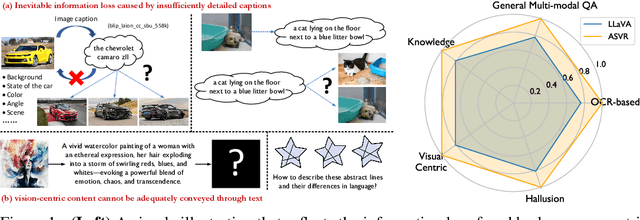

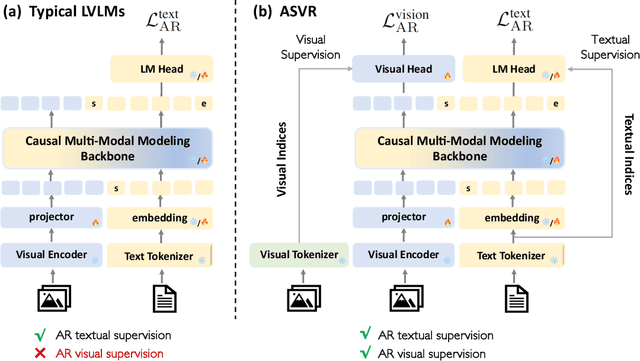

Abstract:Typical large vision-language models (LVLMs) apply autoregressive supervision solely to textual sequences, without fully incorporating the visual modality into the learning process. This results in three key limitations: (1) an inability to utilize images without accompanying captions, (2) the risk that captions omit critical visual details, and (3) the challenge that certain vision-centric content cannot be adequately conveyed through text. As a result, current LVLMs often prioritize vision-to-language alignment while potentially overlooking fine-grained visual information. While some prior works have explored autoregressive image generation, effectively leveraging autoregressive visual supervision to enhance image understanding remains an open challenge. In this paper, we introduce Autoregressive Semantic Visual Reconstruction (ASVR), which enables joint learning of visual and textual modalities within a unified autoregressive framework. We show that autoregressively reconstructing the raw visual appearance of images does not enhance and may even impair multimodal understanding. In contrast, autoregressively reconstructing the semantic representation of images consistently improves comprehension. Notably, we find that even when models are given continuous image features as input, they can effectively reconstruct discrete semantic tokens, resulting in stable and consistent improvements across a wide range of multimodal understanding benchmarks. Our approach delivers significant performance gains across varying data scales (556k-2M) and types of LLM bacbones. Specifically, ASVR improves LLaVA-1.5 by 5% in average scores across 14 multimodal benchmarks. The code is available at https://github.com/AlenjandroWang/ASVR.
OneSug: The Unified End-to-End Generative Framework for E-commerce Query Suggestion
Jun 07, 2025Abstract:Query suggestion plays a crucial role in enhancing user experience in e-commerce search systems by providing relevant query recommendations that align with users' initial input. This module helps users navigate towards personalized preference needs and reduces typing effort, thereby improving search experience. Traditional query suggestion modules usually adopt multi-stage cascading architectures, for making a well trade-off between system response time and business conversion. But they often suffer from inefficiencies and suboptimal performance due to inconsistent optimization objectives across stages. To address these, we propose OneSug, the first end-to-end generative framework for e-commerce query suggestion. OneSug incorporates a prefix2query representation enhancement module to enrich prefixes using semantically and interactively related queries to bridge content and business characteristics, an encoder-decoder generative model that unifies the query suggestion process, and a reward-weighted ranking strategy with behavior-level weights to capture fine-grained user preferences. Extensive evaluations on large-scale industry datasets demonstrate OneSug's ability for effective and efficient query suggestion. Furthermore, OneSug has been successfully deployed for the entire traffic on the e-commerce search engine in Kuaishou platform for over 1 month, with statistically significant improvements in user top click position (-9.33%), CTR (+2.01%), Order (+2.04%), and Revenue (+1.69%) over the online multi-stage strategy, showing great potential in e-commercial conversion.
MMGT: Motion Mask Guided Two-Stage Network for Co-Speech Gesture Video Generation
May 29, 2025Abstract:Co-Speech Gesture Video Generation aims to generate vivid speech videos from audio-driven still images, which is challenging due to the diversity of different parts of the body in terms of amplitude of motion, audio relevance, and detailed features. Relying solely on audio as the control signal often fails to capture large gesture movements in video, leading to more pronounced artifacts and distortions. Existing approaches typically address this issue by introducing additional a priori information, but this can limit the practical application of the task. Specifically, we propose a Motion Mask-Guided Two-Stage Network (MMGT) that uses audio, as well as motion masks and motion features generated from the audio signal to jointly drive the generation of synchronized speech gesture videos. In the first stage, the Spatial Mask-Guided Audio Pose Generation (SMGA) Network generates high-quality pose videos and motion masks from audio, effectively capturing large movements in key regions such as the face and gestures. In the second stage, we integrate the Motion Masked Hierarchical Audio Attention (MM-HAA) into the Stabilized Diffusion Video Generation model, overcoming limitations in fine-grained motion generation and region-specific detail control found in traditional methods. This guarantees high-quality, detailed upper-body video generation with accurate texture and motion details. Evaluations show improved video quality, lip-sync, and gesture. The model and code are available at https://github.com/SIA-IDE/MMGT.
AutoJudger: An Agent-Driven Framework for Efficient Benchmarking of MLLMs
May 27, 2025Abstract:Evaluating multimodal large language models (MLLMs) is increasingly expensive, as the growing size and cross-modality complexity of benchmarks demand significant scoring efforts. To tackle with this difficulty, we introduce AutoJudger, an agent-driven framework for efficient and adaptive benchmarking of MLLMs that tackles this escalating cost. AutoJudger employs the Item Response Theory (IRT) to estimate the question difficulty and an autonomous evaluation agent to dynamically select the most informative test questions based on the model's real-time performance. Specifically, AutoJudger incorporates two pivotal components: a semantic-aware retrieval mechanism to ensure that selected questions cover diverse and challenging scenarios across both vision and language modalities, and a dynamic memory that maintains contextual statistics of previously evaluated questions to guide coherent and globally informed question selection throughout the evaluation process. Extensive experiments on four representative multimodal benchmarks demonstrate that our adaptive framework dramatically reduces evaluation expenses, i.e. AutoJudger uses only 4% of the data to achieve over 90% ranking accuracy with the full benchmark evaluation on MMT-Bench.
OViP: Online Vision-Language Preference Learning
May 21, 2025
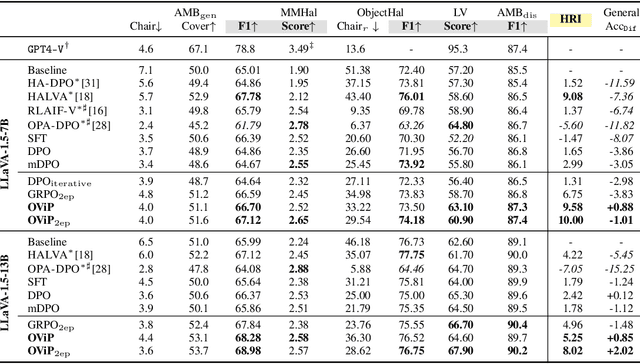
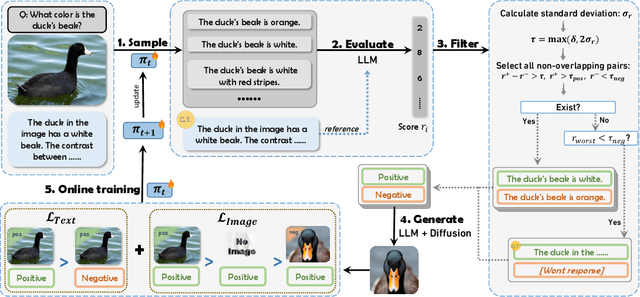

Abstract:Large vision-language models (LVLMs) remain vulnerable to hallucination, often generating content misaligned with visual inputs. While recent approaches advance multi-modal Direct Preference Optimization (DPO) to mitigate hallucination, they typically rely on predefined or randomly edited negative samples that fail to reflect actual model errors, limiting training efficacy. In this work, we propose an Online Vision-language Preference Learning (OViP) framework that dynamically constructs contrastive training data based on the model's own hallucinated outputs. By identifying semantic differences between sampled response pairs and synthesizing negative images using a diffusion model, OViP generates more relevant supervision signals in real time. This failure-driven training enables adaptive alignment of both textual and visual preferences. Moreover, we refine existing evaluation protocols to better capture the trade-off between hallucination suppression and expressiveness. Experiments on hallucination and general benchmarks demonstrate that OViP effectively reduces hallucinations while preserving core multi-modal capabilities.
Not All Models Suit Expert Offloading: On Local Routing Consistency of Mixture-of-Expert Models
May 21, 2025Abstract:Mixture-of-Experts (MoE) enables efficient scaling of large language models (LLMs) with sparsely activated experts during inference. To effectively deploy large MoE models on memory-constrained devices, many systems introduce *expert offloading* that caches a subset of experts in fast memory, leaving others on slow memory to run on CPU or load on demand. While some research has exploited the locality of expert activations, where consecutive tokens activate similar experts, the degree of this **local routing consistency** varies across models and remains understudied. In this paper, we propose two metrics to measure local routing consistency of MoE models: (1) **Segment Routing Best Performance (SRP)**, which evaluates how well a fixed group of experts can cover the needs of a segment of tokens, and (2) **Segment Cache Best Hit Rate (SCH)**, which measures the optimal segment-level cache hit rate under a given cache size limit. We analyzed 20 MoE LLMs with diverse sizes and architectures and found that models that apply MoE on every layer and do not use shared experts exhibit the highest local routing consistency. We further showed that domain-specialized experts contribute more to routing consistency than vocabulary-specialized ones, and that most models can balance between cache effectiveness and efficiency with cache sizes approximately 2x the active experts. These findings pave the way for memory-efficient MoE design and deployment without compromising inference speed. We publish the code for replicating experiments at https://github.com/ljcleo/moe-lrc .
VGDFR: Diffusion-based Video Generation with Dynamic Latent Frame Rate
Apr 16, 2025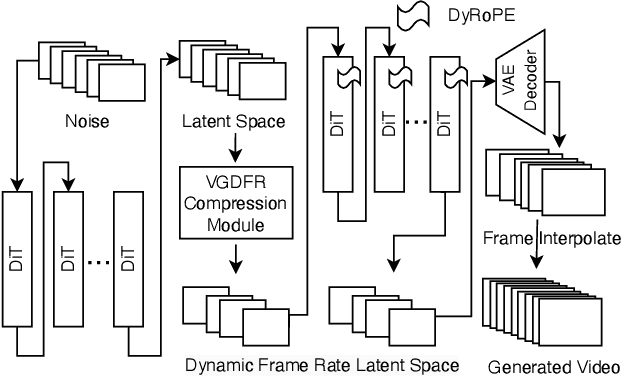
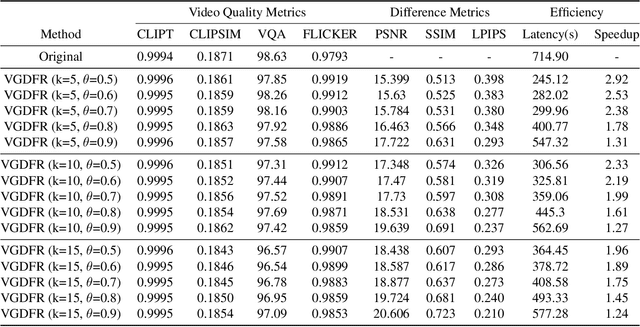

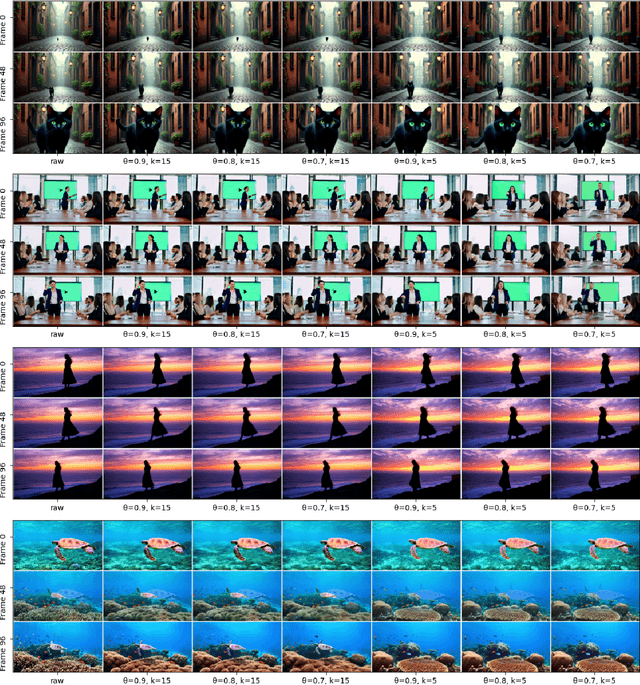
Abstract:Diffusion Transformer(DiT)-based generation models have achieved remarkable success in video generation. However, their inherent computational demands pose significant efficiency challenges. In this paper, we exploit the inherent temporal non-uniformity of real-world videos and observe that videos exhibit dynamic information density, with high-motion segments demanding greater detail preservation than static scenes. Inspired by this temporal non-uniformity, we propose VGDFR, a training-free approach for Diffusion-based Video Generation with Dynamic Latent Frame Rate. VGDFR adaptively adjusts the number of elements in latent space based on the motion frequency of the latent space content, using fewer tokens for low-frequency segments while preserving detail in high-frequency segments. Specifically, our key contributions are: (1) A dynamic frame rate scheduler for DiT video generation that adaptively assigns frame rates for video segments. (2) A novel latent-space frame merging method to align latent representations with their denoised counterparts before merging those redundant in low-resolution space. (3) A preference analysis of Rotary Positional Embeddings (RoPE) across DiT layers, informing a tailored RoPE strategy optimized for semantic and local information capture. Experiments show that VGDFR can achieve a speedup up to 3x for video generation with minimal quality degradation.
 Add to Chrome
Add to Chrome Add to Firefox
Add to Firefox Add to Edge
Add to Edge